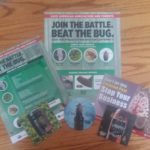Author – Thomas Pike, IR-4 Assistant Coordinator
 The spotted lanternfly is an invasive pest that was introduced to Berks County, PA sometime around 2014. Since then, it has spread further within Pennsylvania and into surrounding states. Given the damage it can cause to fruit trees and grape vines, as well as its potential as a nuisance pest for homeowners, substantial efforts have been made to stop the spread of this insect. On May 6th-7th, the Spotted Lanternfly Regional Summit convened in Harrisburg, PA to discuss ongoing efforts to control the spotted lanternfly. Over 100 members of various organizations such as state Departments of Agriculture, Cooperative Extension, and Bureaus of Forestry, as well as the USDA and National Parks Service, gathered to discuss their efforts to contain and control this insect.
The spotted lanternfly is an invasive pest that was introduced to Berks County, PA sometime around 2014. Since then, it has spread further within Pennsylvania and into surrounding states. Given the damage it can cause to fruit trees and grape vines, as well as its potential as a nuisance pest for homeowners, substantial efforts have been made to stop the spread of this insect. On May 6th-7th, the Spotted Lanternfly Regional Summit convened in Harrisburg, PA to discuss ongoing efforts to control the spotted lanternfly. Over 100 members of various organizations such as state Departments of Agriculture, Cooperative Extension, and Bureaus of Forestry, as well as the USDA and National Parks Service, gathered to discuss their efforts to contain and control this insect.
The first day of the summit saw attendees giving presentations on what their respective organization was doing to help the control effort. These talks were divided into four broad disciplines: operation, communication, research and regulation. The operation talks concerned efforts to track and monitor the spread of spotted lanternfly. This is done through a combination of surveying and reports of individual sightings to create a comprehensive map of the spread of spotted lanternfly. Understanding the limits of how far the insect has spread can allow for more carefully targeted control measures to limit further expansion. The communication talks were all about outreach. The conspicuous nature of this pest, as well as its ability to be a problem in residential areas, means that the general public has a vested interest in helping to control spotted lanternfly and is more able to positively contribute to the control effort in ways that would be impossible for other invasive pests. By canvassing social media with a combination of educational materials and humor (and threats regarding the fate of the local beer and wine industries), these groups have managed to make the public aware of the effort to control spotted lanternfly and have given them the tools and motivation to contribute in whatever manner they can. Research, as the name implies, concerned the ongoing efforts to develop effective means of control for the spotted lanternfly. These ran the gamut from conventional pesticides to egg parasitoids that lay their eggs inside spotted lanternfly eggs and even entomopathogenic fungi that readily infect and kill insects. Finally, the regulation talks were devoted to the quarantines that several states have created to deal with spotted lanternfly. While not established federally, Pennsylvania and New Jersey have established state level quarantines to stymie the spread of spotted lanternfly. One of the components of this quarantine is the establishment of a permit system in Pennsylvania for any business moving materials into or out of the state. By educating these businesses about how to spot the pest, the hope is that they will be less likely to inadvertently move spotted lanternfly to an area in which it has yet to establish itself.
After all of these presentations, the second day of the summit saw attendees separate into one of four breakout sessions, each devoted to one of the disciplines from the first day. After several hours of productive discussion where people could follow up on the presentations from the day before or strategize about future avenues to pursue, the group reconvened and summarized what their respective groups had discussed. After a short discussion about possible improvements to make to the summit for 2020, the meeting concluded.
This meeting was a fantastic opportunity for disparate organizations to coordinate their efforts to control this pest in the most efficient way possible. This sharing of ideas and strategies will allow for those who are working towards managing spotted lanternfly to avoid duplicating their efforts and pursue avenues that wouldn’t have been apparent without this collaboration. Moving forward, I expect the ideas developed at this summit will help make great strides in the fight against spotted lanternfly, and I avidly await the next meeting in 2020.
